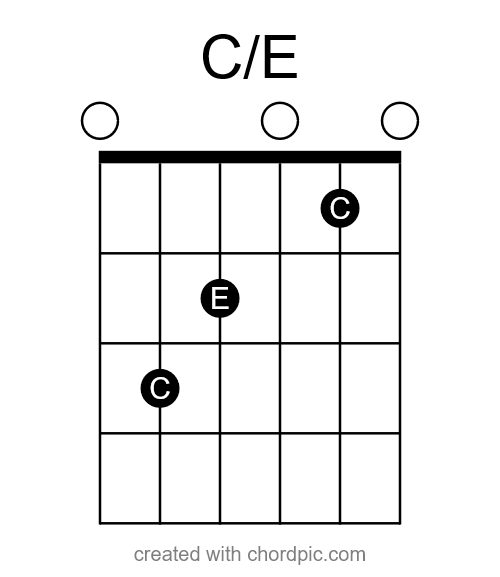Guitar chord inversions are chords that use a note other than the root in the lowest voice.
Inversions come in handy for making our bass lines smoother and more step-wise. On the guitar, utilizing inversions can help you remain in one position instead of making large jumps up and down the fret board.
Major and minor triads have respective chord shapes in each inversion. We will show you how to play these below, as well as additional information regarding inversions and where they are typically used.

Why Do We Need Inversions?
Inversions have been used in music for centuries. Inversions help us to have a smooth bass line that does not require so many jumps, and thus, wasted effort! Stepwise motion tends to be easier to play and has a better sense of flow.
Another reason why composers use inversions is that they don’t sound as stable as root position chords, for this reason they make great passing chords – chords that aren’t meant to be stayed on for too long and are a means to get from one chord to another.
In the baroque and classical periods, inversions were notated with these symbols called figured bass! They are basically roman numerals followed by these little numbers that look like fractions.
Luckily in modern days we don’t have to get a headache over those abstract and complicated symbols, instead slash chords are used to indicate chord inversions. Slash chords are a type of chord that is used in lead sheet notation. Lead sheet symbols are a modern notation used for jazz, rock and pop song books and standards. This notation depicts inversions with a capital letter followed by a slash and the note that should be played in the bass.
An example of this would be the chord C/E. This tells us that a C major chord should be played but with E as the lowest note.

Guitar Chord Inversions Explained
When a chord is played in a different inversion, all it means is that it has a different chord tone in the bass. Because every triad has 3 notes, there are 3 possible inversions that they can be played in. The names of the inversions are root position, 1st inversion, and 2nd inversion.
This is why knowing your chord tones is so important: the lowest note of the chord is not always an indicator of the chord. Additionally, the order of the chord tones do not change that chord. What matters most is that all chord tones are present and accounted for.
Root Position
In root position, the root is the lowest note of the chord. In the example below, a C major chord in open position is shown. Because C is the lowest note played, it is considered to be in root position.

1st Inversion
In 1st inversion, the 3rd of the chord is in the bass. In a C major triad, E is the 3rd of the chord. Because the low E string is now being played open, this C major chord is now technically in 1st inversion.

2nd Inversion
In 2nd inversion, the 5th of the chord is the lowest note. In this example G is the lowest note, so this C major chord is in 2nd position.

Easy Guitar Chord Inversion Patterns
Now that you understand the basis of how inversions work, it is time to learn the major and minor triad inversions shapes up and down the neck.
It is beneficial to attempt to play your major and minor chords in all the inversions up a string set, then move on the next until you have played them all over the guitar.
Note: I did not include diagrams for the 5th string set, as these are played exactly the same as the 6th string set. However, do not skip over them in your practice.
Major Triad Inversion Shapes
6 String Set

4th String Set

3rd String Set

Minor Triad Inversion Shapes
6th String Set

4th String Set

3rd String Set

Frequently Asked Questions
Are slash chords just inversions?
Yes, slash chords are just what some people call inversions because they are written with a slash on lead sheets.
There is one slight exception that I must make, however. Sometimes the slash chord will have a root that is not included on the chord. In this case it would be considered a slash chord yet not an inversion.
How to do chord inversions on guitar?
The best way I would advise practicing your inversions is to play all the inversions beginning on the 6th string set, then make your way downward until you have played all inversions on all string sets. Then, repeat this process for the minor triads. It may seem daunting but honestly this process shouldn’t take more than a few minutes. You get quicker at it with practice.
What is the most common chord inversion?
I am really not sure! In classical music some chords are played exclusively in 1st inversion, such as the Neopolitan 6 chord, or the viio6 chord. I couldn’t tell you exactly why, but something tells me it has to do with good voice leading!
Apart from classical music, I see F/C a lot. This could be because the I- IV -V – I progression in C Major is C – F/C – G/B – C.
If you look closely you can see that the inversions allow you to stay in one position and the bass barely moves, playing the notes C C B C.
How many chord inversions are there on guitar?
This question is impossible to answer, and might not be the right outlook. Don’t worry about learning all of the chords and all of their inversions. The best way to learn guitar is to learn as you go along! Learning how particular chords are built and how they sound is the key to creating them on the fly!
Conclusion
Guitar chord Inversions allow us to have a smooth bass line and minimal movement from our fretting hand. Inversions also allow a better sense of flow from chord to chord in a progression. Additionally, when you use a chord in 1st or 2nd inversion, it lessens the weight of the sound, thus making inverted chords the perfect passing chords.
There are 3 ways in which you can invert a chord. Root position, 1st inversion, and 2nd inversion. In root position the root of the chord is in the bass. In 1st inversion the 3rd of the chord is in the bass, and in 2nd inversion the 5th of the chord is in the bass.
Inversions can really diversify your playing and skill set as a guitarist. Have fun playing guitar chord inversions!
